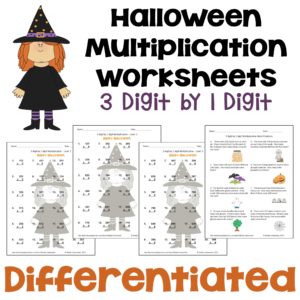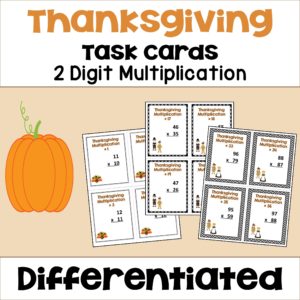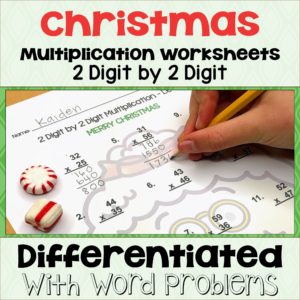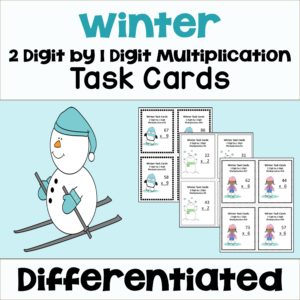Why should students practice multiplication?
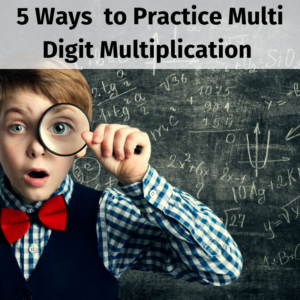 Practicing multi digit multiplication can be a challenge for teachers and students alike. Teachers want to make sure they give students enough practice but students can become bored when using the same resources over and over again.
Practicing multi digit multiplication can be a challenge for teachers and students alike. Teachers want to make sure they give students enough practice but students can become bored when using the same resources over and over again.
I believe that practicing math makes students successful. This is especially true when it comes to the basic operations like addition, subtraction, multiplication, and long division.
Some may call it grill and drill but I like to explain it to my students this way. Think about your favorite athlete (or dancer, or musician, or entertainer). I love soccer so let’s use that as an example. How do you think your favorite soccer player got so good at what they do? Practice. They take thousands of penalty kicks and do countless drills before you see them in the game. It’s not just luck. It’s hard work and lots of practice that makes them be able to effortlessly score goals and weave in and out of defenders.
The same is true with math. The more you practice, the easier it gets. Here are 5 different ways that you can practice multi digit multiplication with your students.
1. Differentiated Worksheets
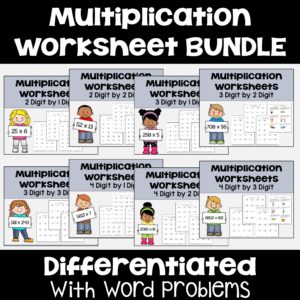 Practicing Multi Digit Multiplication with Worksheets is very common but putting a twist on them by adding differentiation or word problems can make a big difference.
Practicing Multi Digit Multiplication with Worksheets is very common but putting a twist on them by adding differentiation or word problems can make a big difference.
Worksheets are great for homework, morning work, classwork, and math centers. They are great to spiral throughout the whole year. If you use differentiated worksheets, students start with easier questions then move to more challenging ones as they gain confidence. Differentiation is a great way to reach ALL your students.
For example, these worksheets have 4 different levels for each of the topics. Level 1 is the easiest, Level 2 is a little more difficult, and Level 3 is the most challenging. Once students are confident with these questions they can move to word problems for additional practice.
2. Practicing Multi Digit Multiplication with Digital Task Cards
Digital task cards are great because they are self paced. Students can work as slowly as they need to without worrying about holding the rest of the class back. Digital task cards are also self correcting so students have immediate feedback on whether the question is correct or incorrect. Finally, digital task cards are interactive making learning more fun.
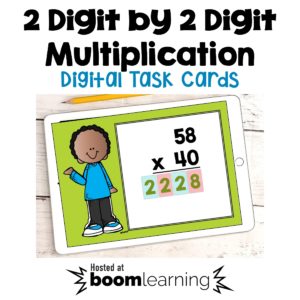 With these digital task cards on BOOM Learning, students can practice their 2 digit by 2 digit multiplication. In the image shown to the right, you can see that the student got 2 of the 4 digits for the answer correct. They can then go back, figure out what they did wrong, then come back and type the correct answer.
With these digital task cards on BOOM Learning, students can practice their 2 digit by 2 digit multiplication. In the image shown to the right, you can see that the student got 2 of the 4 digits for the answer correct. They can then go back, figure out what they did wrong, then come back and type the correct answer.
It’s helpful to have students work the problems out on paper before they type their answers for these digital task cards.
If you’re new to BOOM cards, check out this post on 6 Reasons to Use Boom Cards in Your Classroom.
3. Printable Differentiated Task Cards
Printable task cards are great to have in your classroom and for playing games like Scoot or Around the Room. They are also wonderful for math centers too. Students love the chance to get out of their seats and move around the room.
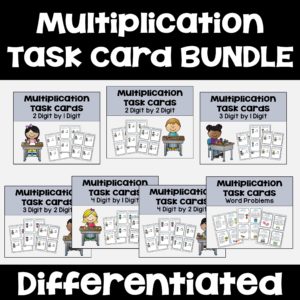 With these differentiated task cards, each of the 3 levels has a different border so you can easily see which level the students are working on. This is great if you want to differentiate for each student. Let’s say you have only 30 minutes for this practice. You can have students that are below grade level practice the level 1 cards (cards 1-12). The students that are at grade level could practice the level 2 cards (cards 13-24). Students that are above grade level could practice the level 3 cards (cards 25-36).
With these differentiated task cards, each of the 3 levels has a different border so you can easily see which level the students are working on. This is great if you want to differentiate for each student. Let’s say you have only 30 minutes for this practice. You can have students that are below grade level practice the level 1 cards (cards 1-12). The students that are at grade level could practice the level 2 cards (cards 13-24). Students that are above grade level could practice the level 3 cards (cards 25-36).
4. Practicing Multi Digit Multiplication with Games
Students love games! The goal is for them to have so much fun they forget that they are practicing math.
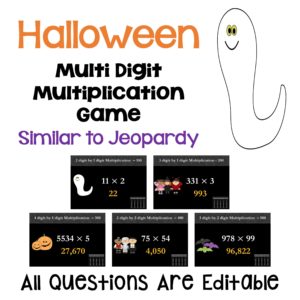 One of my favorite games to play in math class is a digital game similar to Jeopardy. You can play it on any digital white board. Assign teams then ask one member of the team to be the team leader. This is the student who will chose the questions and communicate the group answer to you. All of the students work on the questions independently then compare answers to make sure they have the correct one collaboratively. I let other groups “steal” when the questions are not correct so that encourages everyone to work on all the questions.
One of my favorite games to play in math class is a digital game similar to Jeopardy. You can play it on any digital white board. Assign teams then ask one member of the team to be the team leader. This is the student who will chose the questions and communicate the group answer to you. All of the students work on the questions independently then compare answers to make sure they have the correct one collaboratively. I let other groups “steal” when the questions are not correct so that encourages everyone to work on all the questions.
Games can get a little loud so one trick I use is to call on the quietest team to pick their question. It encourages them to keep the noise level down plus it allows me to manage the game so that all the teams have similar points.
5. Holiday Resources
Holiday resources are great to use all year long. Students get so excited about the clip art and fonts that they forget they are practicing multiplication. It’s a great way to spiral multi digit multiplication throughout the school year.
If you need some easy, no prep holiday resources, here are a couple of my best selling multiplication resources with holiday themes.
I hope you find all these suggestions helpful in Practicing Multi Digit Multiplication with your students.

